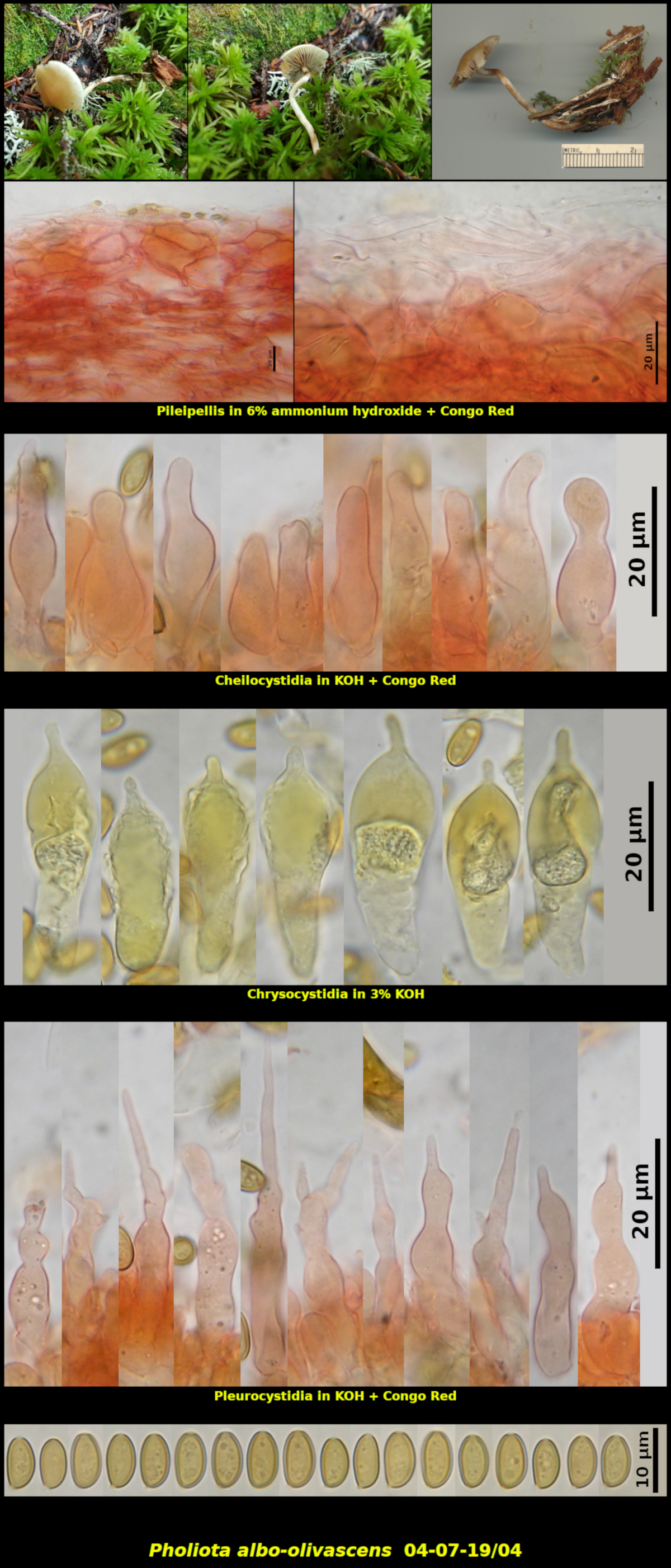Fleshy Fungi of New Brunswick >>
Pholiota albo-olivascens
Pholiota albo-olivascens A.H. Sm. & Hesler

Solitary on rotten conifer wood in forest dominated by Picea rubens, Abies balsamea and Betula papyrifera. Kennedy Lakes Protected Natural Area, Nepisiguit Protected Natural Area, New Brunswick (04-07-19/04).
Basidiospores not forming a visible spore print on a glass slide although there are traces of gelatinous or resinous material where the edges of the lamellae contacted the glass and these are surrounded by a few spores, yellow brown in mass at the stipe apex, ellipsoidal, smooth, with a conspicuous apical to very slightly dorsally subapical germ pore, 7.6-8.8 X 4.1-5.2 μm, Q = 1.68-2.04 (average[31]: 8.3 X 4.7 μm, Q = 1.77). Cheilocystidia forming a continuous sterile margin, ventricose to ventricose-rostrate to lageniform, 17-33 X 5.7-9.2 μm. Pleurocystidia abundant, irregular in shape but usually with a swollen base and an elongated and tapering spear-like apex, with apex often branched and perhaps minutely roughened, 37-53 X 4.4-8.2 μm, often appearing to produce a spore at the apex. Chrysocystidia scattered on the edges and faces of the lamellae, clavate, mucronate, usually with a large amorphous inclusion, bright yellow in 3% KOH, 30-40 X 9.6-13.1 μm. Pileipellis composed of a suprapellis above a pseudoparenchymatous subpellis, with suprapellis a thin ixocutis of narrow clamped hyphae.
Pholiota albo-olivascens appears to be a rare or overlooked species. It has only been reported from a collection from one locality Tennessee and three collections from the one locaity in Massachusetts, all collected in late spring or early summer. There appear to have been no recent reports of the species. This is the first record of P. albo-olivascens from New Brunswick, or indeed from Canada.
This little mushroom does not distinguish itself readily when collected. It has a pale yellow cap and rather olive yellow gills, thus resembling a species of Hypholoma. In contrast, it displays a remarkably distinctive suite of features under the microscope. These features include the thin gelatinous pileipellis overlying a layer of large tightly packed cells, a continuous layer of small cheilocystidia which may excrete a resinous substance, prominent chrysocystidia, and the very peculiar cells labeled here as pleurcystidia. Smith and Hesler (The North American species of Pholiota) discuss these strange pleurocystidia, noting that they sometimes appear to produce a spore at their apex, but that the spore is never discharged. They go on to discuss whether these structures are cystidia or modified basidia and whether these might represent a first step in the evolution of subterranean (sequestrate) fungi.
Photograph: D. Malloch (04-07-19/04).